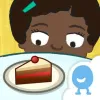
Digital Citizenship Week is October 20–24!
Join teachers worldwide to promote a healthy, positive approach to media and tech.
Take a look inside 6 images
Gracie & Friends Birthday Cafe
Pros: A great learning support system adapts to each kids' learning needs.
Cons: Gameplay may get repetitive and there's no option for creating multiple user accounts.
Bottom Line: Super approach to teaching a very specific topic: Help kids develop an easy familiarity with quantities under five.
Combine screen time with meaningful offline activities, even outside designated "math" lessons. Point out groups of anything -- toys, shoes, pencils, etc. -- and ask how many there are. Then re-arrange the objects and ask again. Have kids practice making quick number judgments to match quantities, such as choosing the right number of napkins to pass out to their table at snack.
Teachers should be aware that progression through Gracie and Friends Birthday Café is personalized, but there's no way to create personalized accounts. Each kid will need to finish all 20 levels before passing the device on to a classmate. Watch kids as they're playing to gauge who's breezing through and who might need extra help beyond the screen.
First 8 Studios has also released a Teacher's Guide for its suite of Grace and Friends apps.
Gracie and Friends Birthday Café is part of a package of free apps and off-screen learning activities for the preschool classroom. Kids match number of party guests with seats at a table, and number of food plates to hungry guests as they seat and serve food to Gracie and her diverse group of friends. To do this, kids must subitize for numbers up to five, or quickly determine how many objects are in a group without counting. For example, drag the group of three guests to the table with three chairs and the group of four guests to the table with four chairs; once everyone is seated, drag the tray that has three plates of food off a moving conveyer belt and deliver it to the table with three guests. Repeat for the table of four. If kids make a mistake, they get extra help; if they keep making mistakes, the game pauses for an in-depth tutorial on counting and recognizing quantity regardless of how the objects are arranged. When kids continue to answer correctly, the conveyer belt gets faster and they must subitize more quickly. There are 20 levels in all.
The learning goal is narrow but crystal clear. Kids get lots of practice making on-the-fly judgments about how many objects there are in groups (up to five), and can up their comfort level with quantities, number names, and number symbols. Simple design and nice progression in difficulty make the game easily accessible. The pedagogical theory and approach is rock solid, and is strongly supported by in-the-classroom research. The best feature here is the stepped scaffolding that clearly and patiently provides kids who are struggling with the extra help they need.
Gameplay is always the same: Seat guests, feed them, repeat. Increasing difficulty should add a little spice and keep kids engaged, but they may find it a bit repetitive. And, while the learning path adapts to individual kids, there's no option for creating multiple user accounts, which may make classroom use a tad tricky.













